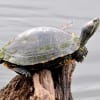 by Jim Stevenson,
by Jim Stevenson,
First, I hope all of you are enjoying family and friends at this time of year, and are concluding a good 2012. This article is actually all the non-birds I photographed this fall, and sending them out is becoming more/less an annual tradition. All kinds of animals!

Relatively few of our snakes are poisonous but this is the venomous Cottonmouth. It has a dark line down its face, through the eye and to the back of the head. Curiously, this one also has an old injury, probably inflicted by a predator which almost got him. This snake species is one of wet areas and will sit with its mouth wide open, exposing the white interior and giving it the name “Cottonmouth.”

Baby Cottonmouths are marked more strikingly (no pun) than the adults and this one is showing the lateral line through the eye very well. They have quite a varied diet and a few have even eaten invertebrates – a rare deed for most snakes. Notice how flat the head is, a good field mark for this species.

This dragonfly pair breeds in my pond and puts on quite a show in the Fall. The gal (top) lays eggs and the male then fertilizes them. They will die later on but the larvae grow all winter and hatch out into adult dragonflies the next spring. Dragonflies are insects that eat insects, and are beneficial to us for eating loads of mosquitoes

The Green Anole may be the most abundant reptile in our Country, although it is an Eastern Deciduous Forest creature of North America. They change color from gray-brown to green, and this male is inflating his gular pouch as a sign of territoriality. Lizards are reptiles because they have watertight skin, scales and a three-chambered heart.

Green Tree frogs are large members of the tree frog genus with suction cups on their toes for climbing. They ride out days in vegetation off the ground and feed and reproduce at night when many of their enemies are asleep. They have large eyes for their nocturnal life and calls which help them find the opposite sex.

Our most common snake on the UTC is the Ribbon Snake, itself a confirmed frog eater. They are diurnal, very slender and quite harmless. This one was hunting tree frogs over my pond and it was all I could do not to remove him. Ribbon Snakes are closely related to Garter Snakes, both in the genus Thamnophis, which means “thicket lover.”

An incredibly abundant reptile in East Texas is the Red-eared Slider, and really, one doesn’t see many other turtles here. This is a female; she has short claws since she has dug burrows. Curiously, Hurricane Ike may have washed them away on Galveston, but I’m not sure. There are many effects of storms on lower vertebrates in coastal areas.

Female (back) turtles are larger than males and the guy in front has almost lost his red “ear.” That’s an indicator of age, with some individual variation. Reptiles are not exactly cold-blooded (poikilothermic) like amphibians and fish, but are technically heliothermic, as they tend to get their heat directly from the sun. This allows them, for instance, to go underwater and feed, maintaining their heat to stay active.

Monarch Butterflies are beautiful and well-known creatures. Curiously, their wings have a bitter toxin in them which protects the species from predation. Similarly-colored kinds like Viceroys have no such toxin but benefit from the fear predators have of the similarly-colored Monarchs. The wintering grounds of the Monarch was found relatively recently near Mexico City, where untold millions of them stay.

The underside of a butterfly’s wings is usually very different from the dorsum, and here the venter shows more silver than red. This species attains its toxin from the food it eats but here it’s just resting on the seeds of a Cherry Laurel. This species migrates through and over the Gulf of Mexico in large numbers every fall.

This dead mullet is covered with an insect many people have had bad experiences with, the shore fly. They often seem innocuous enough but in time may settle down on your leg (especially where there’s no hair) and deliver a painful “bite.” I truly believe their anti-coagulant is worse than any other blood-sucker I have experienced.

This is a large sting ray, one of several species in that complex. These are the depressed members of Chondriicthes, the cartilaginous fishes. -More than one species is fishes-. Their tail barb is coated with the same kind of nasties as catfish spines and sea creatures have learned to beware. The man has a bunch of tattoos but otherwise is built like me. 😉

 Posted in
Posted in 
























